Olympus adapter issues often stem from tolerance variations between components, improper alignment, or electrical contact problems. You’ll face challenges if red alignment dots aren’t matched properly, the lens release button is accidentally pressed, or contact points are dirty. Third-party adapters frequently introduce compatibility problems due to lower manufacturing precision than official Olympus products. Firmware updates on newer camera models can also affect adapter performance. Proper troubleshooting techniques will help you overcome these frustrating connection failures.
Understanding Olympus Microscope Camera Mount Types
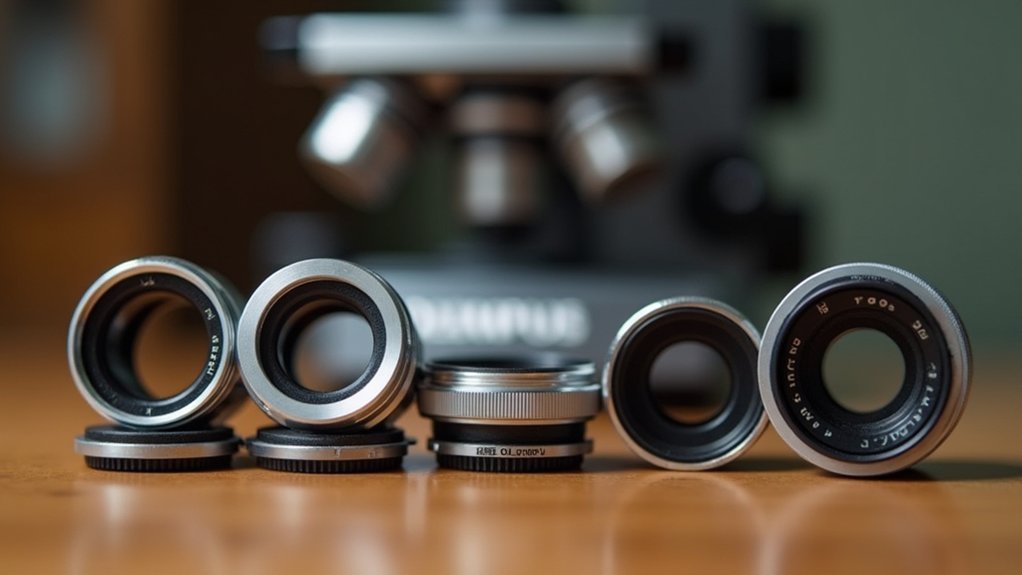
When selecting adapters for your Olympus microscope, it’s vital to first identify the specific mount type your equipment uses.
Most Olympus cameras utilize either C-mount or F-mount systems, each with distinct compatibility requirements.
C-mount is the industry standard with a 1-inch diameter and 32 threads per inch, offering compatibility with numerous cameras and accessories. This versatility makes it a popular choice for many microscopy applications.
In contrast, F-mount systems are typically designed for Olympus’ proprietary microscope models, providing optimized integration and optical performance.
Before purchasing adapters, check your microscope’s specifications to determine its mount type.
Remember that proper alignment is essential—even with the correct adapters, misalignment in the optical path can compromise image quality and functionality of your microscopy system.
Compatibility Challenges Between OM and Micro Four Thirds Systems
Why do so many photographers struggle when trying to adapt Olympus OM lenses to Micro Four Thirds (M4/3) bodies? The issues often stem from inconsistent adapter tolerances that affect how securely your Olympus lenses connect to different camera bodies.
E-M1 series cameras typically handle these adaptations better than E-M10 models, which frequently experience autofocus and communication problems.
Pay close attention to the locking pin alignment—a common failure point that prevents proper mounting. When attaching your lens, verify the adapter rotates completely into position without pressing the release button.
Third party adapters introduce additional variables, as their manufacturing specifications may not perfectly match Olympus standards.
If you’re experiencing connection issues, check that electrical contacts remain unobstructed and try testing your adapter across multiple camera bodies to isolate compatibility problems.
Adapter Tolerances and Their Impact on Image Quality
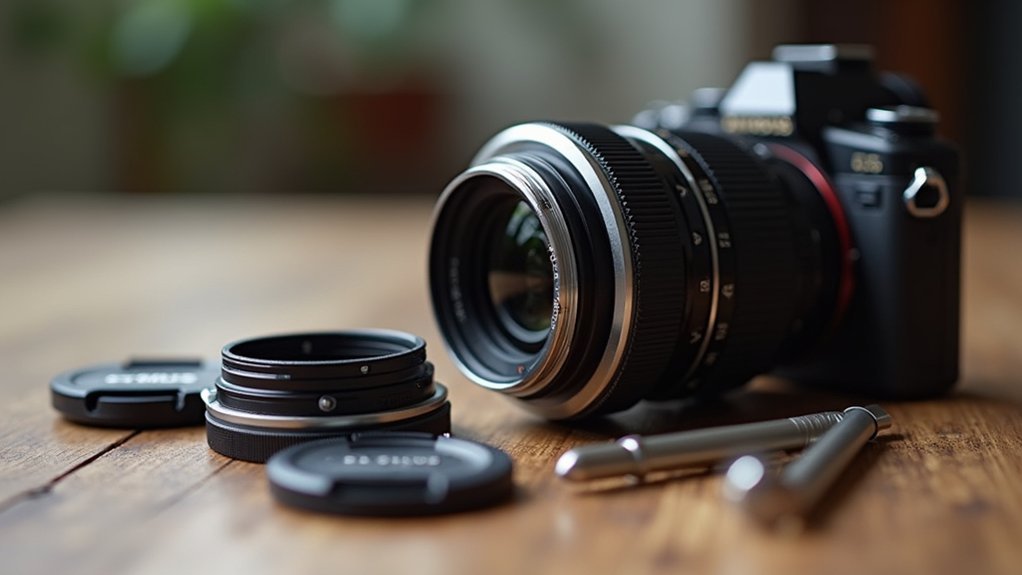
When using Olympus adapters, you’ll find that manufacturing precision variations can greatly affect how well your lenses align with the sensor, potentially degrading edge sharpness in your images.
Metal expansion from temperature changes might alter the adapter’s dimensions during extended shooting sessions, subtly shifting the focal plane and affecting critical focus.
The gradual wear-and-tear on adapter mounting points can worsen these tolerance issues over time, making a perfectly functioning adapter today potentially problematic for your image quality tomorrow.
Manufacturing Precision Variations
The quality of your Olympus camera’s performance can be greatly compromised by even minute manufacturing variations in adapter construction. When third-party manufacturers produce adapters with inconsistent tolerances, your lens works improperly or fails to lock securely onto the camera body.
- Locking mechanism precision – Variations as small as 0.1mm can prevent the release button from engaging properly, resulting in loose connections.
- Contact pin alignment – Manufacturing inconsistencies may cause misalignment between adapter pins and camera contacts, leading to “black screen” issues.
- Material variances – Different metal alloys and production methods affect how adapters wear over time.
Selecting adapters designed specifically for your lens model helps overcome these precision issues.
If you’re experiencing persistent problems despite using compatible equipment, Let’s know in the comments section.
Metal Expansion Effects
Temperature fluctuations can wreak havoc on your adapter’s performance by causing metal components to expand and contract imperceptibly.
When you’re shooting in varying conditions, these dimensional changes affect the critical tolerances between your Olympus lens and camera body.
Your adapter’s locking mechanism depends on precise measurements—even 0.01mm of expansion can prevent proper seating.
You’ll notice this when your previously reliable adapter suddenly feels loose or won’t lock securely.
This misalignment not only creates operational frustrations but can introduce light leaks and compromise image quality.
To minimize these effects, store your equipment at moderate temperatures before use and clean contact points regularly to remove debris that compounds tolerance issues.
Higher-quality adapters typically maintain tighter tolerances across temperature ranges, making them worth the investment for consistent performance.
Wear-and-Tear Considerations
Daily use over time inevitably degrades your adapter’s precise tolerances, creating mounting inconsistencies that directly impact image quality. As adapters age, their ability to create seamless connections between your Olympus camera and lenses diminishes, affecting both functionality and image results.
- Contact point degradation – Worn electrical contacts lead to intermittent autofocus failures and exposure errors, particularly when pairing different brands or models with varying tolerance specifications.
- Locking mechanism fatigue – Repeated mounting/unmounting cycles weaken the secure connection between components, causing subtle misalignments that affect focus accuracy.
- Preventative maintenance – Regular cleaning of adapter contacts removes performance-hindering debris that compounds existing tolerance issues; understanding your specific adapter’s wear patterns helps you select compatible equipment.
Don’t overlook these subtle changes—they’re often the hidden culprits behind unexplained image quality degradation.
Common Mounting Errors With Olympus Microscope Adapters
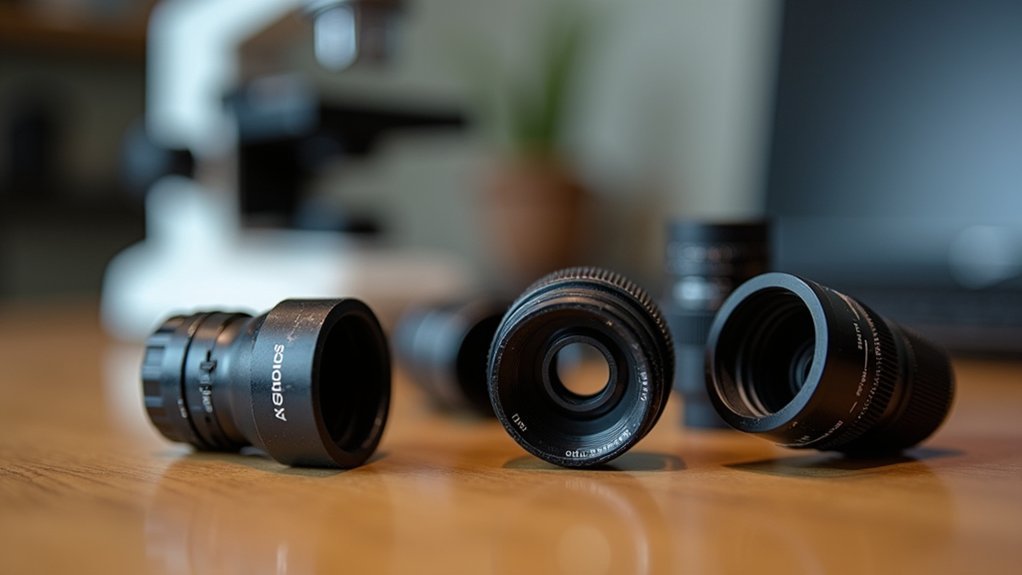
You’ll often encounter alignment pin issues when the red dots aren’t properly matched, causing the adapter to resist mounting properly.
Many users misunderstand the force requirements, applying excessive pressure rather than ensuring correct positioning before gentle rotation.
Adapter tolerance variations, especially in third-party options, can create inconsistent mounting experiences that lead to connectivity failures or compromised image transmission.
Alignment Pin Issues
Frustration often stems from incorrect alignment when mounting Olympus lenses to microscope adapters. Proper alignment of the red dots on both components is essential for a secure connection.
If the alignment pin isn’t correctly positioned, the lens locking mechanism won’t engage, leaving your lens loosely attached or completely incompatible.
- Check for obstructions like dirt or burrs in the locking pin mechanism that prevent proper attachment.
- Confirm you’re not accidentally pressing the lens release button during mounting, which interferes with the locking process.
- Be aware that adapter tolerance variations can cause alignment issues with certain lens models.
Remember that even slight misalignment can prevent your equipment from functioning properly. Always verify the red dots are perfectly matched before attempting to secure your Olympus lens.
Force Requirements Misunderstood
Many photographers struggle with Olympus microscope adapters because they don’t apply sufficient force when mounting their equipment. This common misconception leads to adapters that appear connected but haven’t fully engaged the locking mechanism.
When attaching your adapter, you’ll need to press firmly until you hear or feel a definitive click. Don’t be tentative—the design requires deliberate pressure to secure properly.
Watch out for the lens release button during this process, as accidentally pressing it will prevent the locking pin from engaging.
If you’re still experiencing difficulties after applying appropriate force, check for obstructions in the locking mechanism. Sometimes debris can interfere with proper connection.
Remember that adapter tolerances vary between manufacturers—if one adapter consistently fails to lock, trying a different brand might solve your problem.
Adapter Tolerance Variations
While Olympus sets high manufacturing standards, microscope adapters can still exhibit tolerance variations that create mounting challenges. When you’re struggling to attach your lens, the problem often lies in subtle manufacturing differences that affect alignment between the lens and camera mount.
- Alignment marker mismatches – Always carefully line up the red dots on your lens and adapter before attempting to mount, as even slight misalignment prevents proper connection.
- Locking mechanism issues – Manufacturing defects or wear can compromise the adapter’s ability to secure your lens, requiring gentle but firm rotation until you hear a definitive click.
- Flange obstructions – Dirt particles or metal burrs around the adapter flange can block the locking pin, so inspect and clean these areas regularly.
Always confirm your adapter is fully seated on the camera body to maintain proper electrical contact.
Troubleshooting Black Screen Issues When Using Adapters
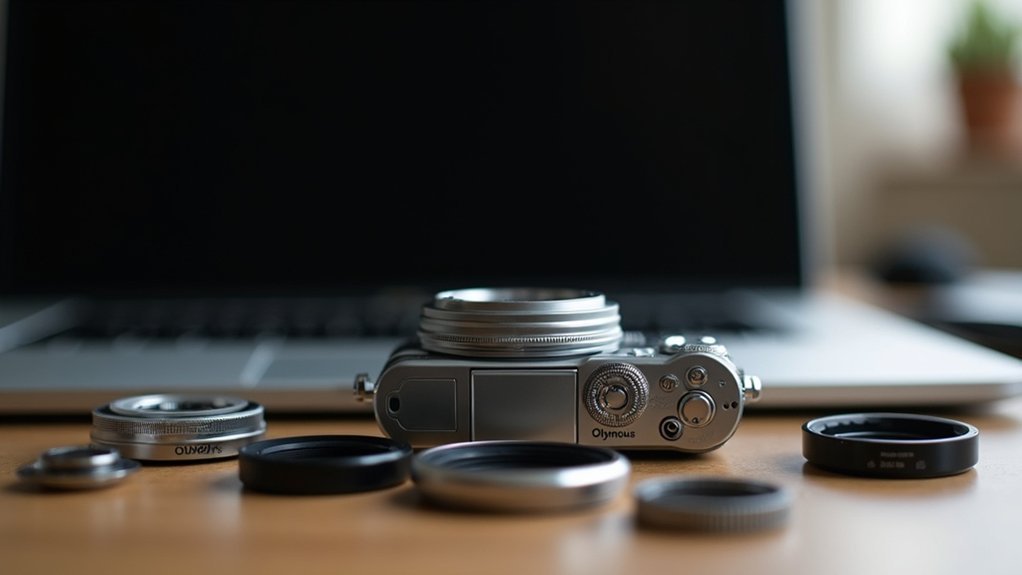
Why does your viewfinder show nothing but blackness when using an Olympus adapter? The most common cause is incomplete lens attachment.
Verify you’ve rotated the lens fully until you hear a click, confirming the adapter’s locking pin has properly aligned with your camera body.
Always rotate your lens until you hear that distinct click—it’s the sound of success when your adapter properly connects.
If the problem persists, clean the electrical contacts on both your lens and adapter to restore proper communication.
Black screens often indicate compatibility issues, especially with newer models like the E-M5 Mk III and E-M10 Mk III.
Check for obstructions in the locking pin mechanism or tolerance issues that prevent proper seating.
Try your adapter on different camera bodies to determine if the problem lies with the adapter itself or with specific lens-camera combinations.
Electrical Contact Problems and Their Solutions
Reliable electrical communication between your Olympus adapter and lens depends on pristine contact surfaces and proper alignment. When your camera displays a black screen or fails to recognize the lens, electrical contact issues are often the culprit.
1. Clean contacts regularly – Use a microfiber cloth or contact cleaner to gently wipe the electrical pins on both your adapter and lens.
Even microscopic debris can interrupt crucial signals between components.
2. Check for alignment – When attaching your lens to the adapter, confirm proper alignment of the electrical pins to prevent communication failures.
Listen for the confirming “click” sound.
3. Verify compatibility – Some adapters don’t support electronic communication with newer Olympus models.
Research compatibility before purchasing to avoid functionality limitations with your specific camera and lens combination.
The Role of Firmware in Adapter Compatibility

Firmware updates play a critical role in ensuring your Olympus camera communicates properly with adapters, often resolving black screen issues or other compatibility problems you might encounter.
You’ll find that older camera bodies may work fine with certain adapters until a firmware mismatch creates compatibility matrix issues, particularly when newer models introduce different communication protocols.
Checking for the latest firmware for both your camera and adapter should be your first troubleshooting step when facing adapter communication problems, as manufacturers frequently release updates specifically to enhance third-party compatibility.
Firmware Update Necessity
While many photographers focus primarily on physical compatibility between their Olympus cameras and adapters, the software side plays an equally important role in guaranteeing peak performance. Your camera’s firmware serves as the essential communication bridge between your body and adapted lenses.
Updating your firmware is critical for three main reasons:
- Enhanced Compatibility – Newer Olympus models like the E-M5 Mk III often require specific firmware versions to properly communicate with older adapters.
- Problem Resolution – Updates frequently fix issues such as black screens or failure to recognize mounted lenses.
- Performance Optimization – Regular updates guarantee you’re getting the maximum capability from your equipment combination.
Don’t overlook checking Olympus’s official website for the latest firmware updates specific to your camera-adapter pairing. These updates might be the solution to your compatibility challenges.
Compatibility Matrix Issues
Despite appearing straightforward on paper, compatibility between Olympus cameras and various adapters forms a complex matrix heavily influenced by firmware versions.
Your newer E-M5 Mk III or E-M10 Mk III might suddenly display a black screen when using adapters that worked perfectly on previous models.
This inconsistency stems from firmware updates that modify how cameras communicate with the differing autofocus systems between 4/3 and micro four-thirds lenses.
An adapter that functions flawlessly on your older camera body might fail completely on a newer model due to these underlying firmware variations.
To navigate this complexity, you’ll need to test adapters across different camera bodies whenever possible.
For guaranteed compatibility, you’re better off investing in official Olympus or Panasonic adapters rather than risking functionality issues with third-party alternatives.
Adapter Communication Problems
Behind almost every adapter failure lurks a firmware issue that’s easily overlooked until problems arise. Your Olympus system may suddenly display black screens or fail to recognize attached lenses simply because your camera’s firmware isn’t communicating properly with your adapter.
Keep your setup running smoothly by understanding these critical firmware facts:
- Firmware mismatches between newer cameras and older adapters often cause the most persistent compatibility issues.
- Regular updates from manufacturers specifically target adapter communication problems, resolving known issues.
- Feature limitations can occur when outdated adapter firmware doesn’t support your camera’s latest capabilities.
Checking for firmware updates for both your camera body and adapter should be part of your regular maintenance routine—it’s often the simplest solution to mysterious communication problems.
Third-Party vs. Official Olympus Adapters: Performance Differences
When choosing between third-party and official Olympus adapters, you’ll find significant performance differences that can impact your photography experience.
Official adapters are specifically engineered to guarantee proper alignment and seamless electronic communication with Olympus bodies, particularly essential for 4/3 lenses on micro four-thirds cameras.
Third-party options often have varying tolerances and build quality that can lead to frustrating issues: black screens, failed locking mechanisms, or misaligned pins.
Many lack proper electronic communication, limiting autofocus capabilities and aperture control with modern lenses.
While third-party adapters may save you money initially, the investment in official Olympus adapters typically results in more reliable performance and fewer compatibility headaches.
Your expensive lenses deserve adapters that won’t compromise their functionality.
Microscope C-Mount Adapter Specifications and Limitations
Understanding C-mount adapter specifications is essential before connecting microscope optics to your Olympus camera system.
These adapters must precisely match the standard 1-inch diameter with 32 threads per inch pitch to guarantee proper attachment. Your adapter needs to provide the correct back focus distance for your specific camera sensor to maintain focus across all magnification ranges.
- Sensor compatibility – C-mount adapters designed for smaller sensors may cause vignetting when used with larger Olympus camera sensors.
- Optical corrections – Some adapters contain built-in optical elements that may interfere with your existing microscope optics.
- Thread precision – Even slight manufacturing variations in thread specifications can prevent secure attachment, causing misalignment or inability to connect properly.
Always verify both the physical and optical specifications before purchasing an adapter for your Olympus system.
Modifying Adapters for Improved Microscope Camera Integration
Though standard adapters offer basic functionality, modifying your Olympus adapters can greatly enhance microscope camera performance. Start by aligning the adapter’s locking pin mechanism to guarantee a secure connection between your camera body and lens.
Before installation, inspect the adapter for burrs or debris that might obstruct the locking mechanism. These impediments can prevent proper mounting and compromise functionality.
Consider adjusting the adapter’s flange thickness to improve fit and alignment, which typically leads to better optical performance with microscope lenses.
Don’t overlook electronic communication capabilities—proper modifications can enhance autofocus and image quality.
Test your modified adapter with various microscope lenses to identify compatibility issues. This hands-on approach allows you to make further refinements based on specific performance requirements, guaranteeing ideal results for your particular setup.
Camera Models With Known Compatibility Issues
Despite Olympus’s reputation for consistency, several camera models exhibit significant compatibility issues with adapters that you should know before making a purchase.
The E-M10 Mark III stands out as particularly problematic, with users reporting black screens and inconsistent performance when using 4/3 lenses with adapters.
Warning: E-M10 Mark III users face black screens and unreliable operation when pairing 4/3 lenses with adapters.
- E-M10 Mark III – Shows uncertain compatibility with 4/3 lenses, often failing where older models succeed due to firmware changes.
- E-M5 Mark III – Similar issues reported with adapter functionality, resulting in black screens during testing.
- Contrast-Only AF Models – Camera bodies relying solely on contrast detection autofocus struggle with adapted 4/3 lenses.
If you’re planning to use older 4/3 lenses, consider the E-M1 series instead, which was specifically designed to maintain compatibility with this legacy glass.
Optimizing Image Stabilization With Microscope Adapters
When connecting microscope adapters to your Olympus camera, properly configuring the image stabilization settings becomes essential for achieving sharp, detailed images. You’ll need to input the correct lens information in custom menu H1 to activate the camera’s in-body stabilization system effectively.
| Setting | Recommendation |
|---|---|
| Lens Info | Input manually in H1 menu |
| Focus Mode | Set to manual focus |
| Stabilization | Confirm it’s activated |
| Adapter Alignment | Check for proper mounting |
| Electronic Communication | Verify compatibility |
Unlike standard lenses, microscope adapters typically require manual focus. If you’re experiencing a black screen or stabilization issues, check that your adapter is properly aligned and fully compatible with your camera model. Remember that adapters without electronic communication may limit stabilization functionality, so choose carefully based on your specific imaging needs.
Lens Registration Distance Challenges in Microscopy Applications
As you venture into microscopy applications with your Olympus camera, understanding lens registration distance becomes critical for successful imaging.
This distance—from lens mount to sensor—can make or break your microscopy setup when using adapters with your Olympus system.
When the adapter’s registration distance doesn’t match your microscope lens specifications, you’ll encounter frustrating focus issues or complete inability to achieve proper alignment with your sensor.
- Verify both your microscope lens and adapter registration specifications before purchase
- Remember that different microscope lenses require specific registration distances
- Watch for symptoms like vignetting or distortion, which often indicate registration distance mismatches
Incompatible registration distances aren’t just inconvenient—they can render your expensive microscope lenses unusable with your camera system.
Frequently Asked Questions
Can You Stack Mount Adapters?
You can stack mount adapters, but it’s not recommended. You’ll face alignment issues, potential light loss, compatibility problems, and vignetting. For best image quality, use a single high-quality adapter instead.
Do You Lose Quality With a Lens Adapter?
Yes, you’ll typically experience some quality loss with lens adapters. High-quality adapters minimize issues, but you may notice reduced sharpness, slight light loss, and increased aberrations, especially with cheaper adapters or wide-angle lenses.
How Do You Attach an Olympus Lens?
To attach an Olympus lens, align the red dot on the lens with the red dot on your camera body. Rotate the lens clockwise until you hear a click, confirming it’s locked securely in place.
Does the Canon Lens Fit the Olympus?
No, Canon lenses don’t naturally fit Olympus cameras due to different mount systems. You’ll need an adapter to connect them, but be aware you’ll likely lose autofocus and electronic functions when doing so.
In Summary
You’re encountering stacking issues because Olympus adapters aren’t designed to work together. Different mount types have specific flange distances that, when combined, create incorrect registration distances. This causes infinity focus problems and potential image quality degradation. Instead of stacking adapters, look for a single solution specifically designed for your application. Check your adapter’s compatibility with your camera model before purchasing additional equipment.

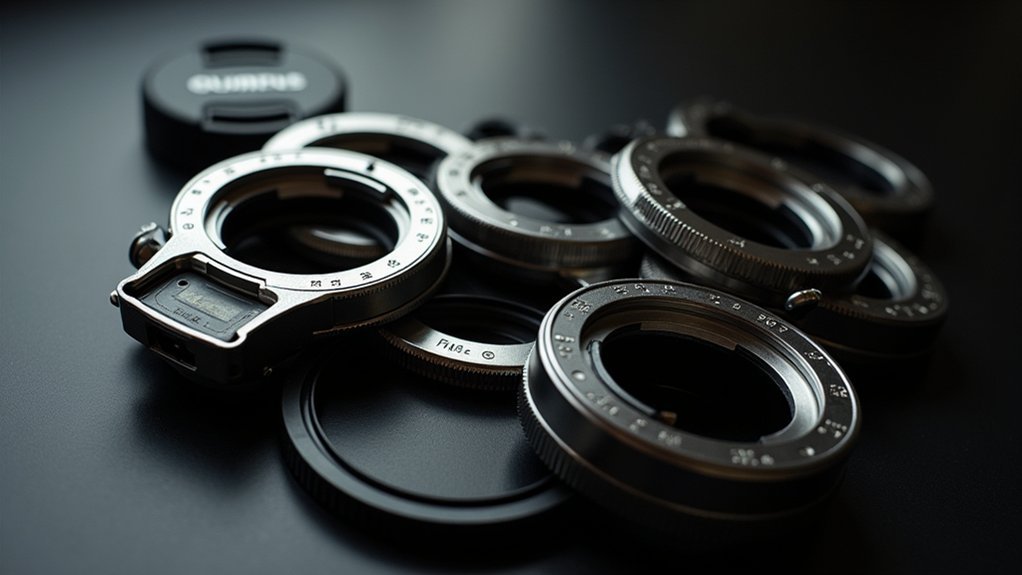



Leave a Reply